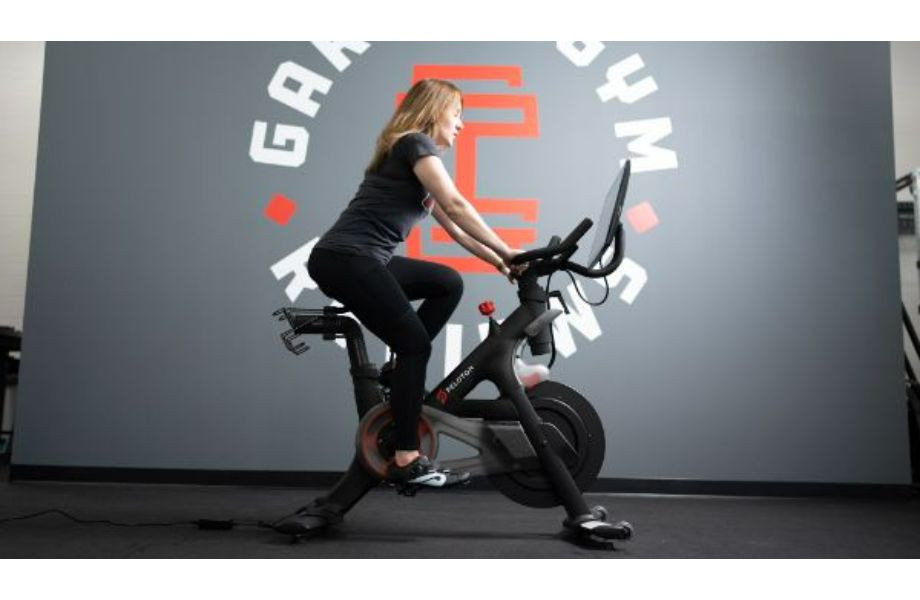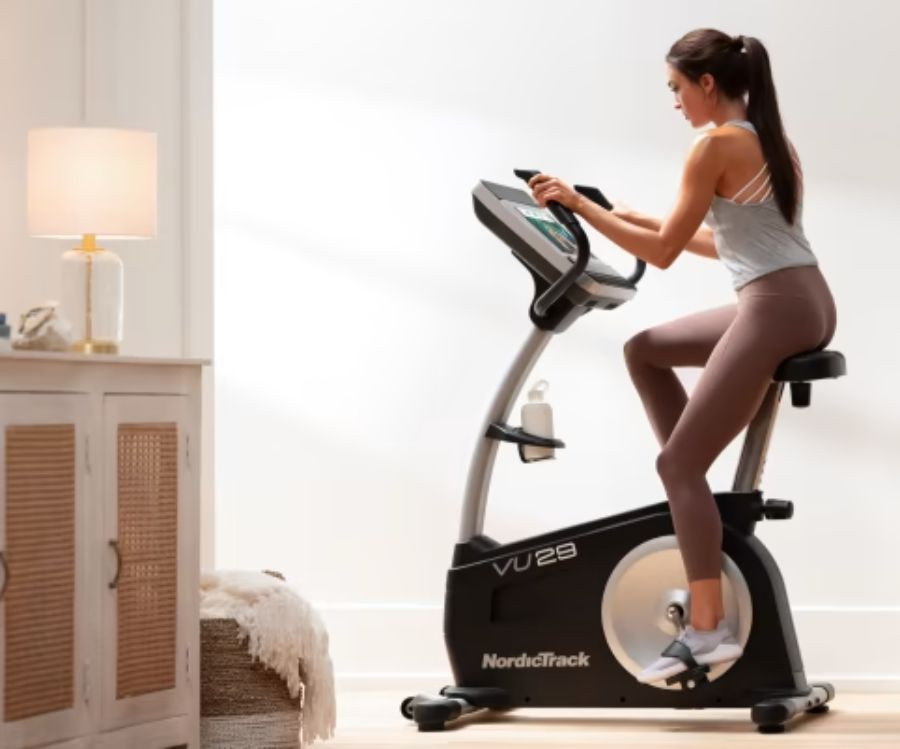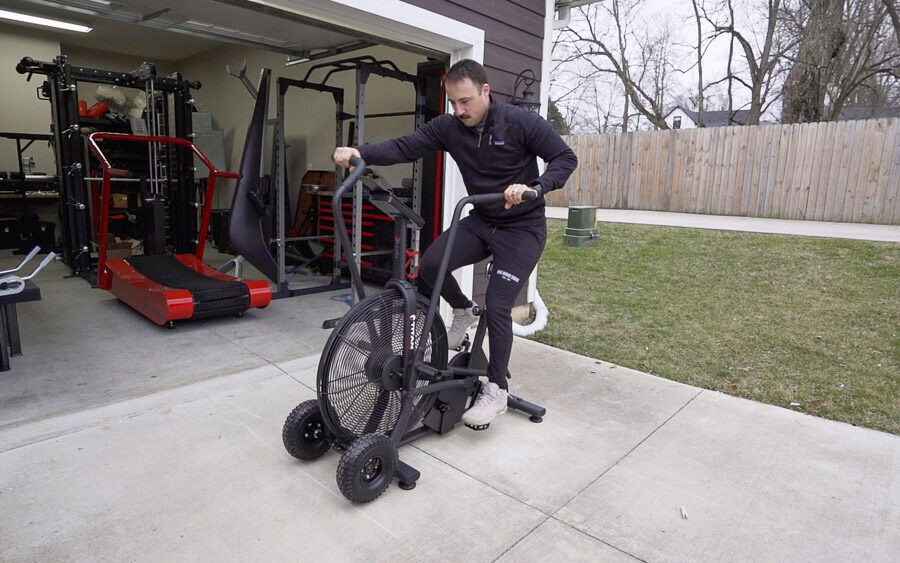Thinking about adding an exercise bike to your home gym? It’s a fantastic decision for cardiovascular fitness, but with so many options available, knowing where to start can be overwhelming. Understanding the different Types Of Exercise Bikes is the first step to finding the perfect match for your fitness goals and space. This guide will explore the five main categories of exercise bikes, highlighting their pros and cons to help you make an informed choice.
There are generally five distinct types of exercise bikes on the market today: recumbent bikes, upright bikes, indoor cycling bikes, air bikes, and folding bikes. Let’s delve into each type to understand their unique features and benefits.
Indoor Cycling Bikes
Indoor cycling bikes are arguably the most recognizable and popular type of stationary bike. Think of brands like Peloton – they’ve brought indoor cycling into the mainstream. These bikes are designed to mimic the feel of riding a traditional road bike, offering a dynamic and engaging workout experience.
 Woman demonstrates indoor cycling on a Peloton exercise bike, a popular type of stationary bike for home workouts.
Woman demonstrates indoor cycling on a Peloton exercise bike, a popular type of stationary bike for home workouts.
With handlebars positioned in front, you’ll naturally lean forward slightly, similar to an outdoor bike posture. This design allows for transitions between seated and standing positions during your workout, engaging different muscle groups and increasing intensity.
The pedals are situated directly beneath your feet, promoting efficient power transfer. Pedal options vary: some bikes come with cages for standard gym shoes, while others feature clip-in pedals requiring specialized cycling footwear for enhanced stability and power. Seats on indoor cycling bikes are typically narrow and firm, prioritizing performance, though aftermarket comfort seats are widely available.
A defining feature of indoor cycling bikes is the exposed flywheel. This mechanism, combined with friction or magnetic resistance, generates varying intensity levels. Resistance is often controlled manually via a knob near the flywheel, allowing for quick adjustments during your workout. Higher-end models may offer digital resistance control for precise and program-integrated adjustments.
Price points for indoor cycling bikes are broad, ranging from budget-friendly options online to premium, feature-rich models. Some, like the NordicTrack S22i, incorporate interactive touchscreens, built-in workout programs, and even dumbbells for a comprehensive workout experience. Others, such as the Schwinn IC4, provide excellent performance at a more accessible price.
| Indoor Cycling Bike Pros | Indoor Cycling Bike Cons |
|---|---|
| Wide variety of options available | Risk of injury from poor form, especially back pain |
| Closely simulates the feel of outdoor road cycling | Limited upper body engagement |
| User-controlled resistance levels for customized workouts | Narrow seats can be uncomfortable for some users |
| Excellent for high-intensity interval training (HIIT) | |
| Compact footprint compared to some other cardio equipment |
Recumbent Bikes
Recumbent bikes offer a distinctly different riding experience compared to traditional upright bikes. The Schwinn 270 Recumbent Bike exemplifies this design, positioning the rider closer to the ground with pedals placed in front of the body, rather than directly underneath. This pedal placement contributes to recumbent bikes being considered the lowest impact type of exercise bike.
The seat design is another key differentiator. Recumbent bikes feature a chair-like seat with a backrest, encouraging a reclined posture. This back support is particularly beneficial for individuals with back pain or mobility limitations, providing comfortable and stable support during exercise. The seats are also generally wider and more padded than other exercise bike seats, enhancing overall comfort.
The accessible design of recumbent bikes makes them well-suited for individuals recovering from injuries, seniors, or those with disabilities. However, it’s worth noting that recumbent bikes may not provide the same high-intensity cardiovascular workout as other types of exercise bikes. The reclined position and lack of standing capability limit core engagement and upper body involvement.
| Recumbent Bike Pros | Recumbent Bike Cons |
|---|---|
| Low to the ground design enhances accessibility | Reduced core muscle activation |
| Backrest provides excellent lumbar support | Limited workout versatility due to fixed riding position |
| Minimal joint impact, ideal for sensitive joints | Larger footprint compared to other exercise bikes |
| Suitable for seniors and those in rehabilitation |
Upright Bikes
The term “upright bike” can sometimes be misleading, as it might be broadly applied to any bike that keeps you in an upright posture. However, a true upright bike is distinct from an indoor cycling bike. While both position you vertically with pedals roughly beneath you, similar to a standard road bike, the key difference lies in handlebar placement.
 Woman demonstrates proper posture while riding an upright exercise bike in a home setting.
Woman demonstrates proper posture while riding an upright exercise bike in a home setting.
Upright bike handlebars are positioned closer to the body, maintaining a strictly vertical posture throughout your workout. This contrasts with the forward lean characteristic of indoor cycling bikes. This closer proximity of seat and handlebars also results in a more compact design compared to other types of exercise bikes.
The seat on an upright bike is typically larger than that of an indoor cycling bike but smaller than a recumbent bike seat, aiming for a balance of comfort and support.
| Upright Bike Pros | Upright Bike Cons |
|---|---|
| Seats are generally more comfortable than indoor cycling bike seats | Fewer upright bike models available on the market compared to other types |
| Smaller footprint than many other exercise bike styles | Some users may find the strictly upright posture less comfortable over extended periods |
| Capable of delivering high-intensity workouts |
Air Bikes
If you’re familiar with CrossFit gyms, you’ve likely encountered air bikes. Unlike indoor cycling bikes that use a flywheel, air bikes are defined by their large fan, which functions as the front “wheel” and resistance mechanism. The faster you pedal, the greater the air resistance becomes, providing a challenging and scalable workout. However, this fan-based resistance is known to generate noise, making air bikes less suitable for quiet workout environments.
 Close-up view of a Titan Fan Bike, showcasing its fan resistance mechanism and sturdy build.
Close-up view of a Titan Fan Bike, showcasing its fan resistance mechanism and sturdy build.
Similar to indoor cycling bikes, air bike pedals are located directly beneath your feet. Seat size and cushioning vary by model; the Rogue Echo Bike is often cited as having a particularly comfortable seat for an air bike.
A significant advantage of air bikes is the inclusion of moving handles, engaging your upper body during workouts. This dual-action design is similar to an elliptical machine, allowing you to incorporate your arms to assist your legs and increase overall exertion.
Air bikes are renowned for providing intense workouts, making them ideal for interval training and HIIT protocols. Despite their intensity, they remain low-impact, suitable for individuals recovering from injuries or seeking joint-friendly exercise.
| Air Bike Pros | Air Bike Cons |
|---|---|
| Provides a highly effective, full-body workout | Fan mechanism can be quite loud |
| Engages upper body with moving handles | Typically have a larger footprint than other stationary bike types |
| Generally priced affordably in the $400-$1,000 range | Resistance level is not adjustable, solely dependent on pedaling speed |
| Basic monitors prioritize function over advanced features |
Folding Bikes
Folding bikes are the ultimate space-saving solution for home workouts. These bikes prioritize portability and compact storage. While they may not be constructed from the most robust materials for intense training, they are available in various designs to suit different needs. Like indoor cycling bikes, folding bikes position handlebars in front and pedals beneath the feet.
 Marcy Foldable Exercise Bike neatly folded and stored in a living room, demonstrating its space-saving design.
Marcy Foldable Exercise Bike neatly folded and stored in a living room, demonstrating its space-saving design.
If you’re seeking a bike for high-intensity cardio, folding bikes may not be the optimal choice. Their foldable design can sometimes compromise stability during vigorous workouts.
Due to their focus on compactness, folding bikes typically lack the advanced features found on indoor cycling bikes. Monitors are often basic, and extras like water bottle or device holders are less common. The Marcy Fitness Foldable Upright Bike is a popular choice, praised for its relative durability within the folding bike category.
| Folding Bike Pros | Folding Bike Cons |
|---|---|
| Extremely small footprint, ideal for limited spaces | Not designed for high-intensity training |
| Easy to fold and store when not in use | Often have lower maximum weight capacities |
| Generally affordable price point | Typically lack advanced features and extras found on other bikes |
Benefits of Using an Exercise Bike
Regardless of the type of exercise bike you choose, incorporating one into your fitness routine offers numerous advantages:
Improved Health
Exercise bikes provide significant health benefits. Cycling elevates your heart rate, effectively burning calories and contributing to weight management. Furthermore, extensive research supports the positive link between regular exercise and improved mental well-being.
Quick and Convenient Workouts
Having an exercise bike at home provides unparalleled convenience for fitting in workouts, even with time constraints. Whether you have a few minutes or prefer shorter, more frequent exercise sessions, a home exercise bike makes it easy. Many bikes offer built-in workout programs for guided sessions, and numerous HIIT bike workouts are readily available for efficient, calorie-burning sessions under 20 minutes.
 Person using an Echelon EX-8s exercise bike for a convenient home workout session.
Person using an Echelon EX-8s exercise bike for a convenient home workout session.
Low-Impact Exercise
All types of exercise bikes offer low-impact workouts. Cycling minimizes stress on joints as your weight is supported, unlike higher-impact activities like running on a treadmill. This makes exercise bikes suitable for individuals of varying fitness levels and those with joint sensitivities.
Full Body Strengthening
Exercise bikes contribute to both muscle building and calorie burning. While primarily targeting the lower body, cycling engages core muscles for stabilization. Air bikes, with their moving handles, further incorporate the upper body for a more comprehensive workout. Any form of muscle engagement during exercise promotes muscle strengthening over time.
Enhanced Cardiovascular Endurance
Regular exercise bike use improves cardiovascular health. Consistent cycling strengthens the heart muscle, reduces the risk of heart disease, and helps regulate blood pressure. Maintaining a healthy cardiovascular system is crucial for overall well-being.
RELATED: Benefits of Indoor Cycling
Final Thoughts
In conclusion, exercise bikes are valuable tools for enhancing overall health and fitness. Whether you are new to exercise or a seasoned athlete, there’s a type of exercise bike to meet your needs. Before purchasing, carefully consider the different types available and which best aligns with your fitness goals, budget, and available space.
FAQs About Types of Exercise Bikes
What is the best type of exercise bike for home use?
Determining the “best” type of exercise bike is subjective and depends entirely on individual needs and preferences. Factors to consider include your budget, fitness goals, desired workout intensity, space availability, and any preferred features like interactive programming.
RELATED: How to Choose an Exercise Bike
What features should I look for when buying an exercise bike?
When selecting an exercise bike, prioritize features that align with your personal needs. For example, if upper body engagement is important, an air bike might be preferable. Key considerations include:
- Price: Establish a budget range.
- Warranty: Assess the manufacturer’s warranty for durability and peace of mind.
- Ergonomics: Look for adjustable and comfortable seats.
- Programming: Decide if built-in workout programs or app compatibility are desired.
What exactly is a stationary bike?
A stationary bike, in essence, is an exercise bike designed to remain fixed in one location during use. The term encompasses various types of exercise bikes, each offering unique features and benefits to suit diverse fitness preferences and requirements.
Kate Meier, NASM-CPT, USAW-L1, CF-L1
Kate brings extensive experience from both the fitness and content creation industries. Her fitness background includes youth athletics, CrossFit affiliate ownership, personal training, weightlifting coaching, and YMCA fitness consulting. Kate is a competitive weightlifter and holds certifications from NASM, CrossFit, and USA Weightlifting.
Further Reading
Tested and Proven: The Best Ellipticals for Home in 2025
Explore our expert reviews and find the best ellipticals for low-impact home workouts. Read more
Tips on How to Get a Good Half-Marathon Time
Learn what constitutes a good half-marathon time and get training advice. Read more
Hyperwear Sandbell PRO Review: In-Depth Review (2025)
Read our comprehensive review of the Hyperwear Sandbell PRO and its versatility for strength training. Read more
How to Fix a Sole Treadmill: Troubleshooting Tips
Find helpful troubleshooting tips for common Sole treadmill issues. Read more
